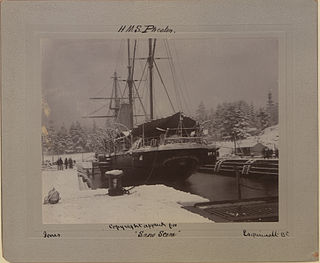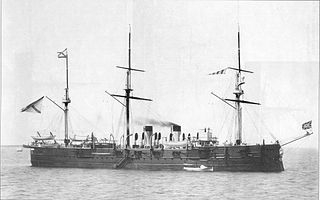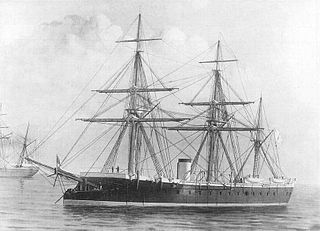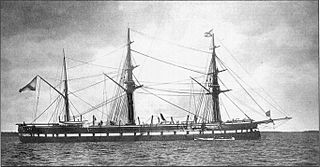
Destroyer escort (DE) was the United States Navy mid-20th-century classification for a 20-knot warship designed with the endurance necessary to escort mid-ocean convoys of merchant marine ships.

George Frederic Watts was a British painter and sculptor associated with the Symbolist movement. He said "I paint ideas, not things." Watts became famous in his lifetime for his allegorical works, such as Hope and Love and Life. These paintings were intended to form part of an epic symbolic cycle called the "House of Life", in which the emotions and aspirations of life would all be represented in a universal symbolic language.

HMS Prince of Wales was one of six 121-gun screw-propelled first-rate three-decker line-of-battle ships of the Royal Navy. She was launched on 25 January 1860.

Destroyer leader (DL) was the United States Navy designation for large destroyers from 9 February 1951 through the early years of the Cold War. United States ships with hull classification symbol DL were officially frigates from 1 January 1955 until 1975. The smaller destroyer leaders were reclassified as destroyers and the larger as cruisers by the United States Navy 1975 ship reclassification so destroyer escorts could be reclassified as frigates (FF) in conformance with international usage of the term.

The Director of Naval Construction (DNC) also known as the Department of the Director of Naval Construction and Directorate of Naval Construction and originally known as the Chief Constructor of the Navy was a senior principal civil officer responsible to the Board of Admiralty for the design and construction of the warships of the Royal Navy. From 1883 onwards he was also head of the Royal Corps of Naval Constructors, the naval architects who staffed his department from 1860 to 1966. The (D.N.C.'s) modern equivalent is Director Ships in the Defence Equipment and Support organisation of the Ministry of Defence.

HMSGannet is a Royal Navy Doterel-class screw sloop-of-war launched on 31 August 1878. It became a training ship in the Thames in 1903, and was then loaned as a training ship for boys in the Hamble from 1913. It was restored in 1987 and is now part of the UK's National Historic Fleet.

Vladimir Monomakh was an armoured cruiser built for the Imperial Russian Navy during the 1880s. The vessel was named after Vladimir II Monomakh, Grand Prince of Kiev. She spent most of her career in the Far East, although the ship was in the Baltic Sea when the Russo-Japanese War began in 1904. Vladimir Monomakh was assigned to the Third Pacific Squadron and participated in the Battle of Tsushima in May 1905. She was tasked to protect the Russian transports and was not heavily engaged during the daylight portion of the battle. The ship was torpedoed during the night and was scuttled the following morning by her captain to prevent her capture by the Japanese.

HMS Phaeton was a second class cruiser of the Leander class which served with the Royal Navy. Paid off in 1903, she then did harbour service until 1913 at Devonport, where she was used for training stokers and seamen. Sold in 1913 to a charitable institution that ran a training ship for boys based at Liverpool, she was renamed TS Indefatigable until repurchased by the Admiralty in 1941 and renamed Carrick II, whereupon she served as an accommodation hulk at Gourock throughout World War II. In 1946 she was sold to shipbreakers Thos. W. Ward in Preston and broken up in 1947.
USS LST-562 was a United States Navy LST-542-class tank landing ship in commission from 1944 to 1946.

The Rosario class was a class of seven screw-sloops of wooden construction built for the Royal Navy between 1860 and 1862. A further six vessels were ordered and laid down, but were cancelled in 1863 before launch. This was the last class of purely wooden sloops built for the Royal Navy.
Sir John Watts was an English merchant, Alderman and shipowner, active in the East India Company and Virginia Company and Lord Mayor of London in 1606.

HMS James Watt was a 91-gun steam and sail-powered second rate ship of the line. She had originally been ordered as one of a two ship class, with her sister HMS Cressy, under the name HMS Audacious. She was renamed on 18 November 1847 in honour of James Watt, the purported inventor of the steam engine. She was the only Royal Navy ship to bear this name. Both ships were reordered as screw propelled ships, James Watt in 1849, and Cressy in 1852. James Watt became one of the four-ship Agamemnon-class of ships of the line. They were initially planned as 80-gun ships, but the first two ships built to the design, HMS Agamemnon and James Watt, were rerated on 26 March 1851 to 91 guns ships, later followed by the remainder of the class.

The Russian cruiser Minin was an armored cruiser built for the Imperial Russian Navy during the 1860s and 1870s. She was renamed Ladoga in 1909 when converted to a minelayer. The ship was sunk in 1915 when she struck a mine laid by a German submarine in the Baltic Sea.

The Pervenets-class ironclads were a group of three armored frigates built for the Imperial Russian Navy in the 1860s. The first ship was built in England because the Russian Empire lacked the ability to build its own ironclads, but the other two were built in Russia. All three ships differed from one another as the design evolved over time. None of the ships ever saw combat and only Kreml had an eventful career, sinking a wooden frigate in an collision in 1869 and sinking herself in 1885. She was refloated and returned to service. They were assigned to the Baltic Fleet upon completion and never left Russian waters. They served with the Gunnery Training Detachment for the bulk of their careers before being reduced to reserve in 1904. They were sold four years later and Pervenets and Ne Tron Menia were converted into coal barges. Pervenets survived World War II and was scrapped in the early 1960s, Ne Tron Menia was sunk during the war and scrapped around 1950, while Kreml's fate after her sale is unknown

The Russian ironclad Sevastopol was ordered as a 58-gun wooden frigate by the Imperial Russian Navy in the early 1860s, but was converted while under construction into a 32-gun armored frigate. She served in the Baltic Fleet and was reclassified as a training ship in 1880. Sevastopol was decommissioned five years later, but was not sold for scrap until 1897.

The Russian ironclad Petropavlovsk was a 22-gun armored frigate in the Imperial Russian Navy during the late 19th century. She was originally ordered as a 58-gun wooden frigate, but she was reordered as an ironclad while under construction and subsequently converted into one. She served as the flagship of the Baltic Fleet during the 1860s and 1870s. The ship was decommissioned in 1885, but was not sold for scrap until 1892.
Events from the year 1819 in Scotland.

The Minotaur is an 1885 painting by the English painter George Frederic Watts. It depicts the Minotaur from Greek mythology as he waits for his young sacrificial victims to arrive by ship. It is an allegorical comment to child prostitution, an issue brought to attention by W. T. Stead in 1885. The painting has been in the collection of Tate Britain since 1897.
United States Navigation Company was founded by Edward Carl Wilhelm Oelsner (1888-1973) in New York City in 1917. Oelsner was a Prussian-born German, who came to America in 1908. In 1915 became a manager of the Hamburg America Line's New York office. In 1917 he became a steamship broker, he then founded his own steamship brokerage firm, United States Navigation Company. United States Navigation Company's first clients were the Hamburg-American Line and North German Lloyd Line. Next Oelsner entered into a joint venture with Biehl & Company chartering ships that serviced the Gulf of Mexico ports. United States Navigation Company when went from just a shipbroker to a ship owner, with the purchase of 1885 SS City of Salisbury, a 397-ton cargo ship. On March 7, 1973, Oelsner died, he and his wife, Eva, were on vacation in Torremolinos, Spain. United States Navigation Company continued doing business. In 1979 the United States Navigation Company was sold and in 1981 closed. The United States Navigation Company supported the World War II effort with its ship and as an operator of United States owned ships.














